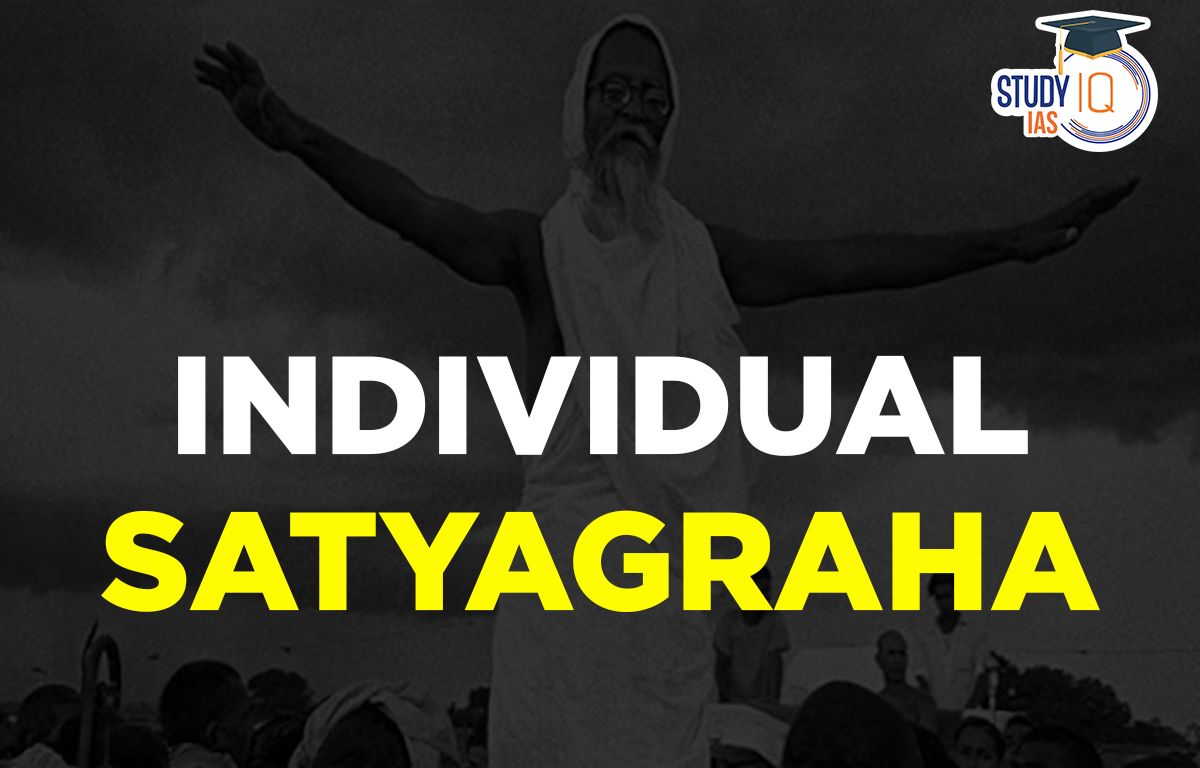Table of Contents
Individual Satyagraha
The August Promise had a direct impact on the emergence of individual satyagraha. The British made the August Offer in 1940, which was a crucial time in the conflict. Congress and the Muslim League both declined the August Offer. The Civil Disobedience Movement was the catalyst, but M.K. Gandhi concentrated on Individual Satyagraha. This organization fought for freedom of expression as well as independence. To use the right to free expression to oppose the war by making an anti-war declaration was Satyagrahi’s demand. The various facets of individual satyagraha for the UPSC Exams are the main focus of this article.
Individual Satyagraha History
The government was adamant that until Congress struck a deal with Muslim leaders, no constitutional progress could be made. It enacted ordinance after ordinance limiting the right to free speech, the freedom of the press, and the ability to organize. Near the conclusion of 1940, Congress requested Mahatma Gandhi to assume leadership once more.
Gandhi now started to take actions that would result in a widespread uprising within his broad strategic view. He decided to start a small-scale protest by a few carefully chosen people in each community.
Individual Satyagraha Feature
Lawmakers were again baffled in the wake of the August Offer. Gandhi insisted on Individual Satyagraha while the radicals and leftists wanted to launch a massive civil disobedience campaign. The Individual Satyagraha started to defend the right to free expression, not to achieve independence. Another justification for this Satyagraha was that a mass campaign might turn violent, and he did not want to embarrass the UK by doing so.
Gandhiji held a diverse viewpoint. On the wreckage of the British Empire, he did not want to erect a free India. Gandhiji wished it known that the British should not take India for granted and that Indians should be entitled to the same freedoms and fundamental rights for which Britain was fighting fascism and Nazi Germany.
He wanted to debunk the British claim that India was fervently supporting the war of her own free will. He encountered Lord Linlithgow on September 27, 1940. He outlined to the Viceroy his desire to abstain from the conflict. Additionally, he wished to ask his people to do this because India’s interests were not being served by this war. He was forced to start his campaign after the Viceroy rejected his proposal.
Individual Satyagraha Objective
Individual Satyagraha’s main goal is to show that nationalist patience was not the product of frailty. Another goal is to demonstrate public disinterest in the conflict and to highlight the differences between Nazism and the dual autocracy that governed India. The government will be given another opportunity to agree to the demands of Congress in a peaceful manner.
To use the right to free expression to oppose the war by making an anti-war declaration was Satyagrahi’s demand. The Satyagrahi will replicate the action in villages and march towards Delhi (Delhi Chalo Movement) if the government does not detain them.
Read More: Quit India Movement
Individual Satyagraha Leaders Involved
The first person selected to present an individual satyagraha was Vinoba Bhave. He launched his mission at Paunar, just five miles from Wardha, on October 17, 1940. He urged the populace not to support the government’s war Endeavour for three reasons in a speech:
- The absence of a provisional national government due to the government’s opposition;
- Dragging India into the conflict without asking or consulting her;
- Restrictions on the ability to speak out against conflict.
From October 18 to 20, 1940, Vinoba Bhave made anti-war addresses in Surgaon, Saloo, and Deoli on consecutive days. He was detained on October 21 and given a three-month jail term. When he is brought before the judge after being arrested, he enters a guilty plea and claims that he did it with a specific objective in mind. To counteract the influence of Congress, the government issued directives on October 25, 1940, outlawing all anti-War propaganda.
This presented a task to Gandhiji, who decided to name Jawaharlal Nehru the second Satyagrahi after Vinoba Bhave. The government detained Nehru on October 31, 1940, at the Cheoki train station near Allahabad for breaking the Defence of India Rules before he could begin his campaign. For his seditious remarks, he received a four-and-a-half-year prison term. Asylum resident Brahma Dutt was the third person selected to perform a satyagraha.
Read More: Non Cooperation Movement
Individual Satyagraha Impact
It allowed the British government to peacefully accept Indian requests while also expressing the strong political feelings of the Indian people. Gandhiji and the Congress were reluctant to exploit Britain’s predicament and humiliate her war effort by inciting a widespread revolt in India due to their anti-Nazi sentiments. Gandhiji was also beginning to organize the populace for the impending conflict. The structure of the House was being changed;
The company was identifying and removing opportunistic elements. Most significantly, people were informed, inspired, and politically mobilized. By May 15, 1941, more than 25,000 Satyagrahis had been found guilty of individual civil disobedience. Many more lower-level political employees were permitted to labour for free by the government.
Read More: Khilafat Movement
Individual Satyagraha UPSC
Several former ministers, members of the Working Committee and All-India Congress Committee, as well as close to 400 members of the Central and Provincial Assemblies, had all been detained before Gandhiji decided to put an end to the campaign of individual civil disobedience for the Christmas holiday. Among them, Maulana Azad and Sardar Vallabhbhai Patel were well-known.
It gained momentum fast, and by the end of January, there had been over 2,250 voluntary arrests. Unfathomable enthusiasm was shown by the activists who offered to be arrested. More than 20,000 individuals had been found guilty in a short period of time. Learn the complete Individual Satyagraha for UPSX Exam information.


 Indus River System, Tributaries, and Sin...
Indus River System, Tributaries, and Sin...
 Jallianwala Bagh Massacre, Date, History...
Jallianwala Bagh Massacre, Date, History...
 Important Lakes of India, State wise and...
Important Lakes of India, State wise and...






















